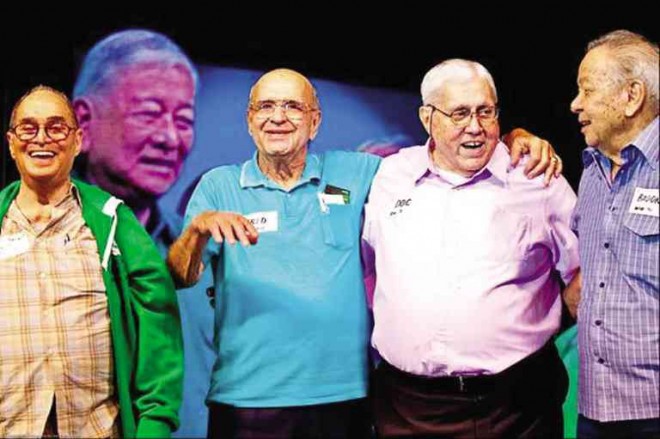
My classmates and I were only 12 years old when the Pacific War broke out in December 1941. By the time the war was over in August 1945, our wartime experiences propelled us from childhood into adulthood in just four years. In the process, adolescence was bypassed.
Shortages in basic necessities began to be felt after the fall of Bataan and Corregidor in May 1942. That prompted our resilient moms to modify the family’s lifestyle and adjust it to unaccustomed circumstances.
Business and commerce were down because of the disconnect between suppliers and distributors. We became acutely aware of the difficulties of being an archipelago. Shipping vessels were not operating because fuel was unavailable. Trade between islands was carried out by fragile sailing boats called “batels.”
Sorely missed were food items and manufactured goods which were imported in large quantities before the war. I used to accompany my mother who made it a habit to shop at the Philippine Cold Storage where all kinds of imported meat products were available. For middle-income families, shopping via mail order catalogs of Sears Roebuck and Montgomery Ward was very popular before the war. All kinds of consumer items packed in large boxes were ordered and timed to arrive before school started and at Christmastime.
On top of wide-scale shortages, there was the more critical problem of diminished earnings. Members of my class at La Salle were mostly children of businessmen or professionals like lawyers, doctors, engineers, military officers, government officials. Our families encountered much difficulty in making both ends meet during the Japanese occupation. Hence, even the youngsters in the family were asked to pitch in and help fill the income gap. And we responded with gusto.
We were given time to assist the family because high school classes ended at noon. Ting Paterno, for instance, was conductor of the family-owned transportation vehicle called “jitney,” the forerunner of the postwar jeepney. Jitneys were actually old cars that were converted into public transportation vehicles. The motive power for these vehicles was provided by an invention of Hilarion Henares Sr. which used the humble coconut shell as fuel.
My classmate, Eddie Tordesillas, was the driver (cochero) of another form of public transportation, the caretela, a horse-driven rig. Eddie and his caretela plied the route from Plaza Sta. Cruz to the end of Aviles Street (now J.P. Laurel Street).
During afternoons, Alfred Ysrael, the eldest of five children was seen around the vicinity of Pasay’s Leveriza Street guiding a bunch of goats to forage in empty lots and garbage areas. Those goats, he claimed, provided rich milk for the children and meat for the family.
Ernie Martelino, the son of a colonel in the Philippine Scouts, went into the fresh egg business. He would buy eggs wholesale from the Tutuban terminal of the railroad line. Early each day, Ernie would bring his bike to deliver eggs to customers even before school started.
Before the war, the father of another classmate, Manuel Igual whom we called Doc, was actively engaged as an international trader of coconut products like copra and coconut oil. The war forced Doc’s dad to focus his attention on the domestic market. Doc was enlisted to help his dad sell a type of coco chemical which was a principal ingredient in the fabrication of bath soap.
Doc’s best friend in class was MendiMendieta, the youngest son of a wealthy hacendero from Oriental Negros. Because the Pacific War separated them from its only source of income, family members including 15-year-old Mendi sought employment wherever they could obtain it. Mendi became a teller at the San Lazaro racetrack.
Ernest Martinez was the son of a UP professor who had quite a good number of children to support. Ernest tried to pitch in by working in his uncle’s workshop in the Sta. Cruz district, north of the Pasig River. To save money, he used to walk from his home in Singalong to his uncle’s workshop.
Peping Nunez belonged to the scholarly Zulueta clan. During the Japanese occupation, he spent most afternoons tutoring grade school pupils. The father of Gus Escueta joined the guerilla outfit in Zambales headed by Ramon Magsaysay. So Gus quit school to look after the family’s fishponds in Bulacan.
This unforgettable wartime journey was the precursor to the bigger role we played in later life. Ting became a highly respected Cabinet member. As his undersecretary, Eddie became a close collaborator of Ting.
We lost track of Alfred after he migrated to Guam in 1951. On the 65th anniversary of our High School Class of 1947, Alfred suddenly reappeared. To our classmates’ surprise, he donated P24 million to La Salle’s Scholarship Fund.
Ernie pursued a dual career. After working 30 years in the company, he retired as managing director of Exxon Chemicals, Philippines. Ernie then worked as executive of San Miguel Corporation. Eight years later, he retired once more with the title of vice president.
Doc became head honcho of two factories producing construction materials. Mendi rose from the ranks and was appointed president of Tabacalera.
Ernest retired as the CEO of an Ayala-owned nonlife insurance company. Gus headed the local branch of the pharmaceutical firm Johnson & Johnson.
Looking back, it seemed that there were more “achievers” among my classmates than in the graduating classes that immediately followed us. It was also noticeable that we were also more hardworking than our younger siblings. This was no mere accident nor was the difference due to the fact that we were more intelligent.
Finally, it dawned on me. All the adversities we went through during the war would strengthen our character. We just didn’t realize it then.